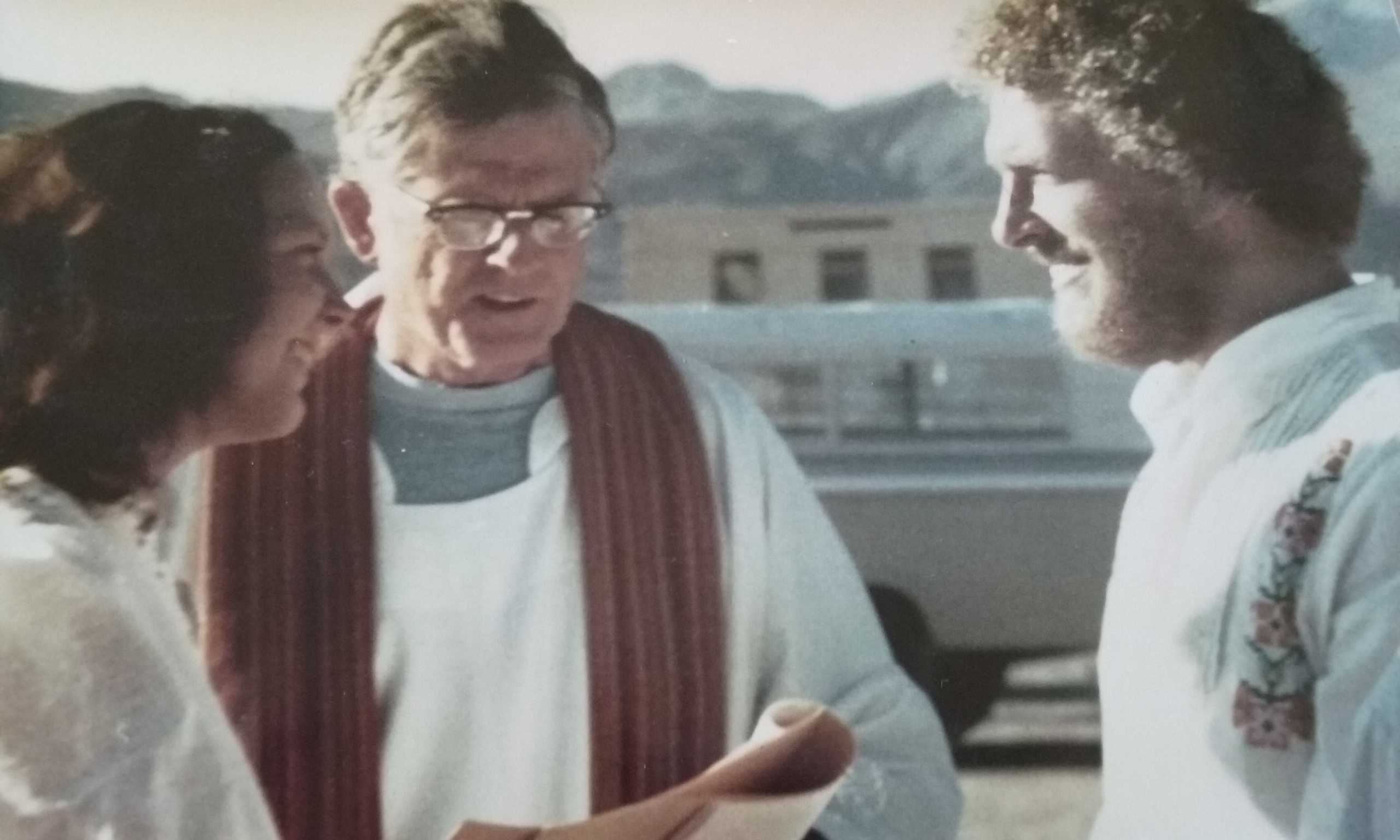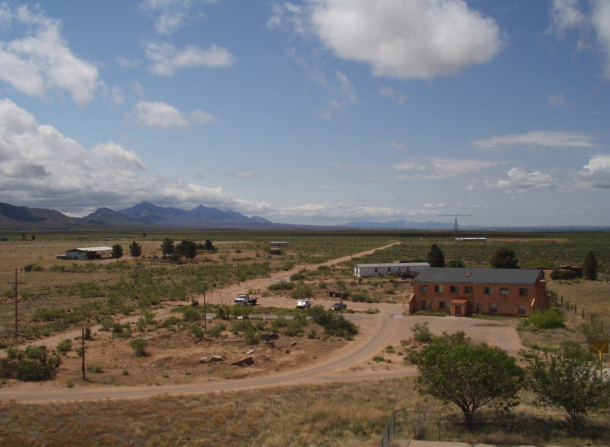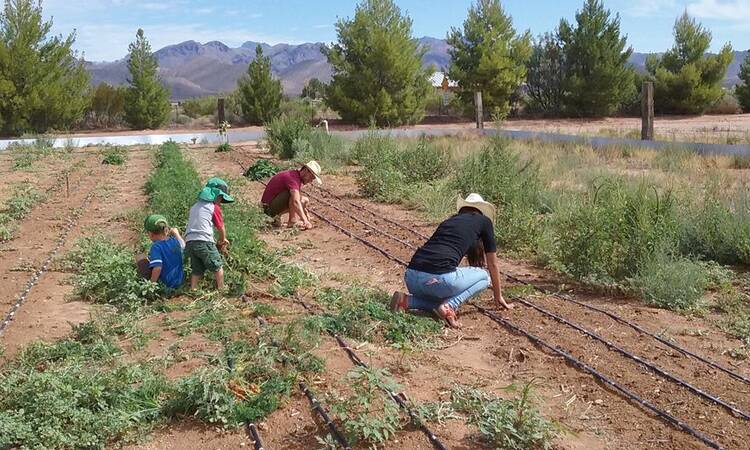My parents fell in love while milking cows. My mom, Mary Ann, was the first full-time volunteer to move to The Lord’s Ranch, a lay, Catholic, missionary community founded in 1975 by Richard M. Thomas, S.J., in the desert of southern New Mexico. She arrived in 1976 and lived with two other volunteers in a small shack with an outhouse. My dad, Mike, joined her a few years later from Rhode Island. Before I joined the Jesuits in 2003, I grew up there with my seven siblings, doing many things that ranch boys do. At the age of 5, I was a goat and cow milking instructor for the many visitors who would come through the ranch to do volunteer work. I fed and watered the horses. I burned tumbleweeds and raked manure. And I went on regular Sunday afternoon horseback rides for three-hours with my mentor, Father Thomas.
Since the publication of Rod Dreher’s book The Benedict Option, people have asked me: “Didn’t you grow up with the Benedict option?” My response is ambivalent. On the one hand, I see why they think so. The Lord’s Ranch is a community that embodies some of the principles of the Benedict option. It is set apart from the mainstream culture and bound together by common property and common practices. It aims to be a Christian community in the fullest sense, living like the poor and being obedient to Acts 2:44: “All who believed were together and had all things in common.” Not that I had any idea that I was poor. I remember the first time a volunteer asked me while playing Ping-Pong how I felt about growing up poor. I indignantly replied that I was definitely not poor. We chose to live this way. We chose to live the option for the poor.
The Lord's Ranch seeks not the preservation of identity so much as dedication to an outward mission.
But for other reasons, I resist the Benedict option characterization. It leaves too much out. Dreher describes the Benedict option as “withdrawal for the sake of renewal,” for the sake of recovering our Christian “cultural identity.” He draws inspiration from the concluding words of the philosopher Alisdair MacIntyre in his influential book, After Virtue: “This time however the barbarians are not waiting beyond the frontiers,” writes MacIntyre. “They have already been governing us for quite some time. And it is our lack of consciousness of this that constitutes part of our predicament. We are waiting not for a Godot, but for another—doubtless very different—St. Benedict.”
The Benedict option is an act of resistance to the hegemony of mainstream culture that tends to suffocate Christianity. It calls for us to enclose, to protect, to ensure continuity.
“How can you serve where the Lord is calling you to if you have to have air conditioning and are bothered by flies?”
The Lord’s Ranch also demands a kind of withdrawal, but its motivation is different. It seeks not the preservation of identity so much as dedication to an outward mission. Ellen Hogarty, one of Father Thomas’s closest collaborators from 1983 until his death in 2006, and now one of the leaders of The Lord’s Ranch, recounts the way the ranch’s mission drove members’ spirituality. “Father Thomas taught us that all things have been given to us by God and are to be used generously in the Lord’s service, in whatever mission he calls us to,” said Ms. Hogarty. “He proposed an exercise of going through all your belongings, one by one, and saying, ‘This belongs to God.’ This house, this bed, this toothbrush, this car, this computer...belongs to God.”
Spiritual disciplines like these were meant to free the community not simply from attachment to the world but for service. Ellen Hogarty related the words of Father Thomas: “How can you serve where the Lord is calling you to if you have to have air conditioning and are bothered by flies?”

Father Thomas’s favorite catchword was “flexibility,” which conveniently summarized one of St. Ignatius’ key principles, found in one of his letters: “Always with one foot raised, ready to hasten from one place to another.” That is perhaps why my dad used to tell me, half-jokingly, that he considers himself a “third order Jesuit.” “I think a part of Ignatian spirituality is simplicity,” he recently told me. “Years ago we voluntarily decided to live without heating or cooling in our homes. We don’t use clothes dryers or microwaves. We want to, in some way, live like the people we serve.”
Both the Benedict option and the option presented by The Lord’s Ranch—call it the Ignatius option—demand a kind of withdrawal. In the case of the latter, however, the motivation for withdrawal is formation for mission rather than countercultural resistance.
You can't preach the good news and be the bad news.
When we were young, my seven siblings and I were home-schooled, no doubt to shield us from certain negative cultural influences. But my parents’ intentions went deeper: Being home-schooled freed us to participate more fully in the mission of The Lord’s Ranch and allowed us to be shaped more profoundly by service to the poor.
I was free to visit the prisons in Juárez, Mexico, on Wednesdays and the homes of shut-ins on Fridays. I will never forget the first time, as a young teenager, that I stepped into one of the small holding tanks in a jail in Juárez. The stench from the overflowing exposed toilet in the corner hit me full in the face. The cement room was completely filled with shirtless men covering every available space. We gave them lunch (they were not fed during their time in jail) and started talking about Jesus. I held conversations with young men my age who had been sliced up in gang fights. That was an education for mission that no school could have provided.
I was also free to participate in the pro-life ministries of The Lord’s Ranch. From his early years protesting against racism as a Jesuit scholastic, Father Thomas came to understand that the pro-life cause was the most important social justice issue of our time. He made this movement a central feature of the work of our community. My dad joined him in several “rescues” outside of abortion clinics, nonviolently blocking clinic entrances and spending time in prison. Many residents of the ranch participated in these rescues, me and my siblings included, although we were too young to be arrested.
This culture of resisting unjust laws and practices was a crucial part of my upbringing and has remained a central part of my identity as a Jesuit priest.
We also spent innumerable hours picketing for a large variety of causes. There is a running joke in our community: “If you’re not sure what to do, picket!” This culture of resisting unjust laws and practices was a crucial part of my upbringing and has remained a central part of my identity as a Jesuit priest. Ranch residents and community members continue to picket consistently about a variety of causes, including abortion, migrant rights, immigration policies and the death penalty.
It was an education as much in learning to discern the murmurs of the Spirit as in prioritizing the poor. Mike Reuter, a missionary who arrived at the ranch in 1985 from North Dakota, is now married to Norma, a fellow missionary who moved to the ranch in 2006. They have five children. For him, authenticity in living the Ignatius option requires just such an education because it calls us “to remind ourselves to be very flexible. Not to be afraid of changing things as we go.”
This openness to change signifies “a total reliance on the Holy Spirit to lead us and correct us,” Mr. Reuter said. “As missionaries we are constantly being asked to trust that the Lord will provide for what he wants to do in the ministry, in our life, even in my family life, and in the changing of the ministry.”
There is a running joke in our community: “If you’re not sure what to do, picket!”
Like Jesuits, the lay Catholic missionaries who live on The Lord’s Ranch live in community. Like Jesuits (perhaps even better than Jesuits), they voluntarily choose to live simply. Like Jesuits, many make an annual silent Ignatian retreat. Like many Jesuits, they serve the poor. But most important, as Mike Reuter suggests, members of The Lord’s Ranch live a radical openness to discerning the guidance of the Holy Spirit.
Aspects of both the Benedict option and the Ignatius option are needed for the church, in both religious life and lay communities. Where Benedictines take vows of stability and emphasize tradition in their style of prayer and rhythm of life, Jesuits tend to offer mobility and innovation. Pope Benedict XVI reminded the Jesuits at their 35th General Congregation in 2008 of their call to go to the “frontiers.” Those who feel called to follow the Ignatius option must fight to preserve their distinct mission orientation.
My brother, Joshua O’Halloran, returned to The Lord’s Ranch with his wife, Rebekah, and three children five years ago and took charge of the farming and livestock. Joshua frames the work in terms of the need for fidelity to the mission.
Aspects of both the Benedict option and the Ignatius option are needed for the church.
“It would be easy to turn the ranch into a trendy farm, where a few families live and enjoy a sustainable lifestyle as an alternative to business in our world today,” he said. “I consistently hear from visitors to the ranch how we should start selling grass fed beef or market local honey” (Joshua and Rebekah also keep bees). The intention behind these suggestions is good but misses the point. “We exist to serve the poor and to be a place where visitors can encounter Christ. Every decision we make is based on discerning whether it will benefit the people we serve and our mission.”

A person who is a full time community member of The Lord’s Ranch cannot have a paying job. On the ranch, one’s time belongs to the Lord and the people one is called to serve. The Lord’s Ranch is dedicated at every moment to living out the mission of Christ. As Father Thomas used to say repeatedly, “You can’t preach the good news and be the bad news.” Members of the community know that God will take care of them as long as they build their life around their mission, and this experience of complete dependence fills them with tremendous joy. My mom, who has lived on the ranch since the beginning, puts it this way: “We are not a social service. We are a Catholic lay community.” At the heart of that identity is a radical dependence on God’s generosity. Commitment to embodying this radical dependence is lived in concrete practices that bind the community together.
“We are not a social service. We are a Catholic lay community.”
“We try to live simply yet functionally,” she said. “We get what we need to further the kingdom. We live off donations, which helps us try to stay simple in our daily life.... We trust God to provide, trusting that if we are doing God’s will, then he will pay for it.”
Yet there is also a deep recognition that practices are not ultimately enough; nothing but the love of Christ can sustain the community. “If what we do, no matter how small, is not done with great love, then it doesn’t amount to a hill of beans,” my mom said. “We realize that without Jesus, we can’t do a dang thing.”
The two options are not mutually exclusive. The commitment of members of The Lord’s Ranch’s to elements of the Benedict option, like a countercultural witness in their lifestyle, are incorporated into a mission orientation that reflects an Ignatian option. “The mission is multidimensional,” said Rebekah. “Service to the poor in this area is the obvious mission. But in its mission of service to the poor, The Lord’s Ranch also serves as a countercultural beacon, directing the lives of many visitors to greater service to those most vulnerable in our midst.”
“If what we do, no matter how small, is not done with great love, then it doesn’t amount to a hill of beans,”
Joshua described to me an example of the influence the ranch has on visitors. “Recently we received a 19-year-old visitor to The Lord’s Ranch who came to volunteer for two weeks,” he told me. “He was from an insulated background and had never left home. On the ranch, he worked on an organic farm, joined a protest for immigrant farm worker rights, visited the poor in Juárez and played soccer with Juárez youth.”
As he was leaving, the young visitor shared that “he had never known about the plight of immigrant farm workers and how they lived, or put a face to immigrants fleeing violence or seeking a better life for their families.” Everything he experienced, and every day of his time on the ranch, was transformative and gave him a new perspective on his own life.
At a time when some American Catholics are starving for the kind of nourishment offered by the Benedict option, Father Thomas’s vision and the missionaries on The Lord’s Ranch offer further sustenance in the Ignatius option. It is a radical option that slices cleanly through the layers of individualism and self-sufficiency that insulate secular American culture. (It is also not always a very practical option—“God is not practical” was one of the most familiar sayings of Father Thomas.) It molded me into the Jesuit I have become and continues to form Christians to face the challenges of our day. While some are waiting “for another—doubtless very different—St. Benedict,” on The Lord’s Ranch I was formed by another Ignatius, Father Thomas. The option he established there continues to flourish.
=========================
The Lord’s Ranch
Founded in 1975 by Rick Thomas, S.J., in Vado, N.M.
A mission of Our Lady’s Youth Center, a lay, nonprofit organization with ministry centers in El Paso, Tex, and Juárez, Mexico, focusing on service to the poor and pro-life issues.
Mission statement: Called together to a life of prayer, faith and agape love, we are striving to be a Christian family. We work together, have fun together, struggle and grow together. Obedient to the Roman Catholic Church and attentive to discernment, we seek to live in service to our brothers and sisters in need by practicing the spiritual and corporal works of mercy.
Mike and Mary Ann Halloran serve as directors of The Lord's Ranch.
The ranch welcomes group and individual volunteers: www.thelordsranchcommunity.com










